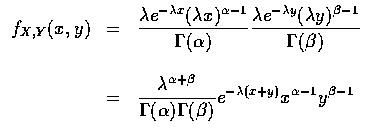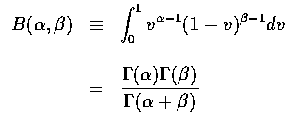
Joint Probability Distribution Functions of Random Variables
設 X1 和 X2 為聯合連續隨機變數, 其聯合機率密度函數為 f x1 ,x2. 有時我們必需去算 Y1 和 Y2 的聯合分布, 其中 Y1 和 Y2 分別是 X1 和 X2 的函數. 特別地, 對某些函數 g1 和 g2, 我們令 Y1 = g1 (X1,X2),Y2 = g2 (X1,X2). 假設函數 g1 和 g2 滿足下列條件:

在這兩個條件下, 可以證得 Y1 和 Y2 為聯合連續隨機變數, 其聯合密度函數為



 ,
,
 ,
,


![$\begin{array}{rcl}
f_{U,V}(u,v)&=&f_{X,Y}[uv, u(1-v)]u \\ \\
&=&\displaystyle\...
...}(1-v)^{\beta-1}\Gamma(\alpha+\beta)}
{\Gamma(\alpha)\Gamma(\beta)}
\end{array}$](img13.gif)

The above result is quite interesting. For suppose there are n+m jobs to be
performed, with each (independently) taking an exponential amount of time with
rate ![]() for performance, and suppose that we have two workers to perform
these jobs. Worker A will do jobs
for performance, and suppose that we have two workers to perform
these jobs. Worker A will do jobs
![]() ,
and worker B will do the
remaining m jobs. If we let X and Y denote the total working times of
workers A and B, respectively, then X and Y will be independent gamma
random variables having parameters
,
and worker B will do the
remaining m jobs. If we let X and Y denote the total working times of
workers A and B, respectively, then X and Y will be independent gamma
random variables having parameters
![]() and
and
![]() ,
respectively. Then the above result yields that independently of the working
time needed to complete all n+m jobs (that is, of X+Y), the proportion of
this work that will be performed by worker A has a beta distribution with
parameters
,
respectively. Then the above result yields that independently of the working
time needed to complete all n+m jobs (that is, of X+Y), the proportion of
this work that will be performed by worker A has a beta distribution with
parameters
![]()